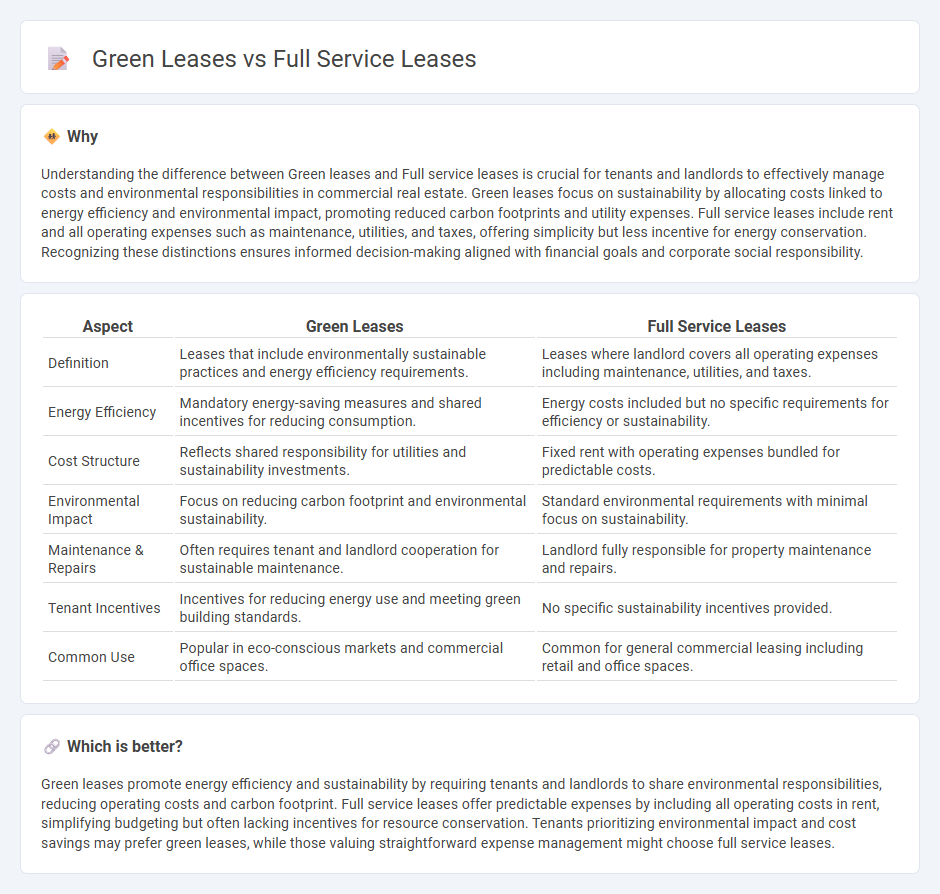
Green leases promote energy efficiency and sustainability by allocating costs based on actual usage, aligning tenant and landlord incentives to reduce environmental impact. Full service leases include all operating expenses in the rent, providing tenants with predictable monthly payments but less control over utility consumption. Explore the benefits and drawbacks of each lease type to determine the best fit for your real estate needs.
Why it is important
Understanding the difference between Green leases and Full service leases is crucial for tenants and landlords to effectively manage costs and environmental responsibilities in commercial real estate. Green leases focus on sustainability by allocating costs linked to energy efficiency and environmental impact, promoting reduced carbon footprints and utility expenses. Full service leases include rent and all operating expenses such as maintenance, utilities, and taxes, offering simplicity but less incentive for energy conservation. Recognizing these distinctions ensures informed decision-making aligned with financial goals and corporate social responsibility.
Comparison Table
| Aspect | Green Leases | Full Service Leases |
|---|---|---|
| Definition | Leases that include environmentally sustainable practices and energy efficiency requirements. | Leases where landlord covers all operating expenses including maintenance, utilities, and taxes. |
| Energy Efficiency | Mandatory energy-saving measures and shared incentives for reducing consumption. | Energy costs included but no specific requirements for efficiency or sustainability. |
| Cost Structure | Reflects shared responsibility for utilities and sustainability investments. | Fixed rent with operating expenses bundled for predictable costs. |
| Environmental Impact | Focus on reducing carbon footprint and environmental sustainability. | Standard environmental requirements with minimal focus on sustainability. |
| Maintenance & Repairs | Often requires tenant and landlord cooperation for sustainable maintenance. | Landlord fully responsible for property maintenance and repairs. |
| Tenant Incentives | Incentives for reducing energy use and meeting green building standards. | No specific sustainability incentives provided. |
| Common Use | Popular in eco-conscious markets and commercial office spaces. | Common for general commercial leasing including retail and office spaces. |
Which is better?
Green leases promote energy efficiency and sustainability by requiring tenants and landlords to share environmental responsibilities, reducing operating costs and carbon footprint. Full service leases offer predictable expenses by including all operating costs in rent, simplifying budgeting but often lacking incentives for resource conservation. Tenants prioritizing environmental impact and cost savings may prefer green leases, while those valuing straightforward expense management might choose full service leases.
Connection
Green leases and full service leases both integrate sustainability and operational efficiencies into commercial real estate agreements by aligning tenant and landlord responsibilities for energy use and maintenance. Green leases promote environmentally friendly practices through shared obligations for resource conservation, while full service leases include comprehensive costs, often encompassing utilities and building services that support green initiatives. This connection enhances building performance, reduces operating costs, and fosters collaborative efforts toward sustainability goals.
Key Terms
Operating Expenses
Full service leases typically include operating expenses such as maintenance, utilities, and property taxes within a single rent payment, providing tenants with predictable monthly costs. Green leases, on the other hand, incorporate sustainability clauses that encourage energy efficiency and shared responsibility for operating expenses between landlords and tenants, often resulting in lower utility bills and environmental impact. Explore detailed comparisons and benefits of each lease type to optimize your commercial property strategy.
Sustainability Clauses
Full service leases typically include fixed rent covering all operating expenses, often lacking specific sustainability obligations, whereas green leases integrate sustainability clauses requiring tenant and landlord collaboration on energy efficiency, waste reduction, and environmental performance targets. Such clauses may involve commitments to LEED certification, energy consumption reporting, and use of renewable resources to promote long-term ecological benefits and cost savings. Explore further to understand how sustainable lease agreements can enhance environmental responsibility and financial viability.
Utility Management
Full service leases bundle utility costs such as electricity, water, and gas into the rent, simplifying payments but often leading to less control over consumption and costs. Green leases incorporate utility management clauses promoting energy efficiency, sustainability initiatives, and cost transparency, aligning tenant and landlord incentives to reduce environmental impact. Discover how green leases can optimize utility management and drive sustainable savings in commercial real estate.
Source and External Links
Pros and Cons of a Full-Service Lease: Landlord's View - A full-service lease (or gross lease) involves a fixed rent that covers base rent plus all operating expenses like utilities, maintenance, property taxes, insurance, and property management, simplifying tenant obligations and offering landlords stable income and lower vacancy risk.
WHAT IS A FULL SERVICE LEASE? - CARR.us - A full-service lease charges one all-inclusive rental rate covering base lease and operating expenses such as taxes, insurance, and maintenance, commonly used in office and industrial properties, often with escalation clauses for increases after the base year.
A Guide to Full Service Lease (with Examples) - IPG - Full-service leases offer tenants a predictable monthly cost including base rent and operating expenses (property taxes, insurance, common area maintenance), sometimes including utilities and janitorial services, typical in office buildings, helping avoid unexpected costs during the lease term.
 dowidth.com
dowidth.com